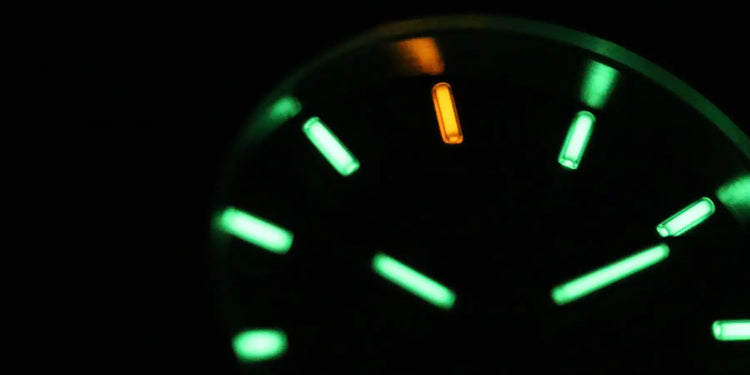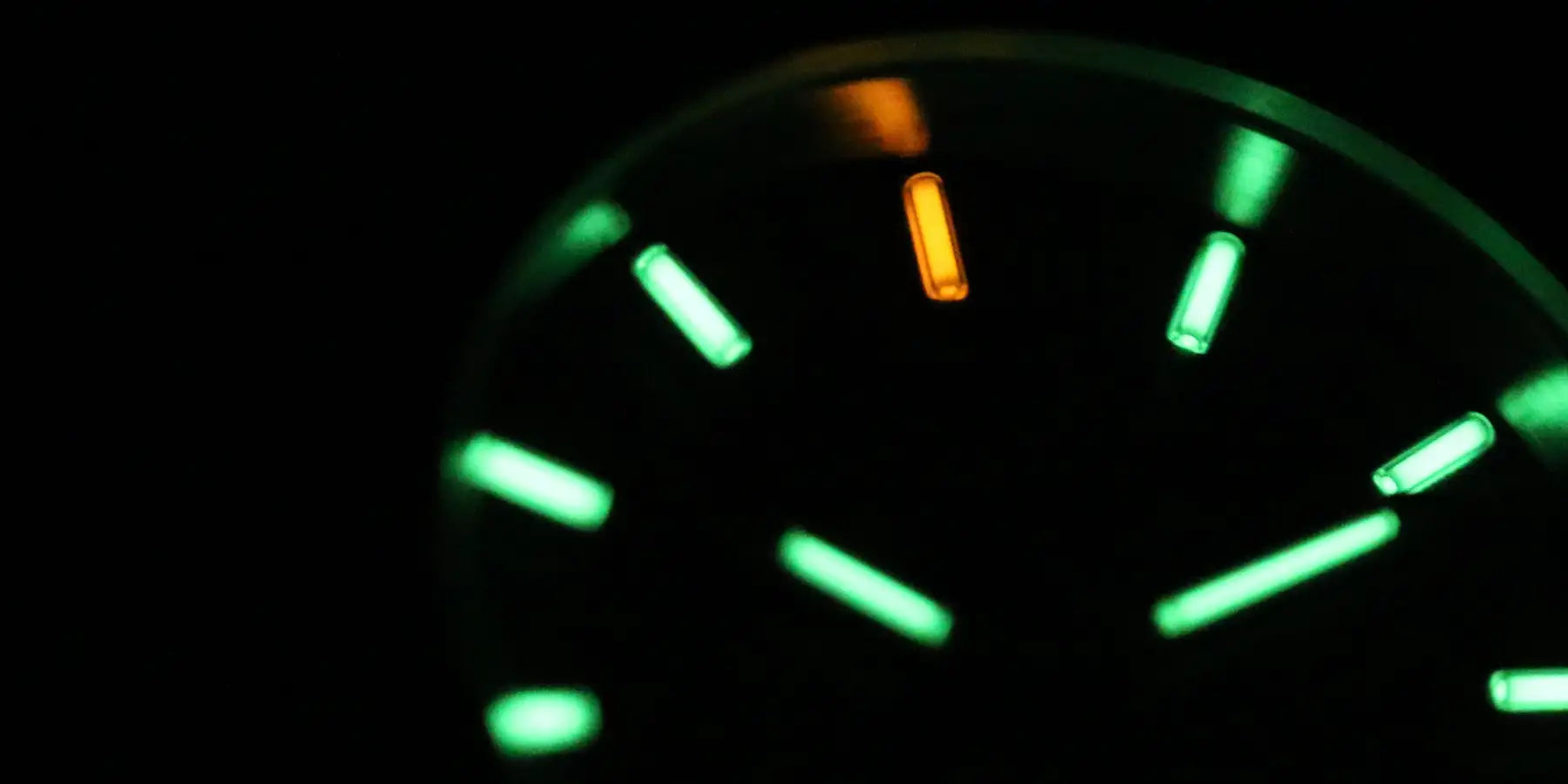Key Takeaways
- Tritium illumination uses radioactive decay to create continuous glow without charging
- Beta particles from tritium atoms strike phosphor coating to produce visible light
- GTLS tubes contain tritium gas and phosphor in sealed borosilicate glass capsules
- The process happens millions of times per second creating steady illumination
- Swiss mb-microtec GTLS technology sets the global manufacturing standard
- Works continuously in all conditions unlike paint that fades within hours
Understanding How Tritium Illumination Works
What we've found works best when explaining tritium illumination to people who need equipment that performs in the dark is starting with the fundamental process. This technology operates through controlled radioactive breakdown that directly produces visible light, no external power required, no batteries, no charging.
Tritium is a special form of hydrogen that naturally breaks down at a predictable rate. As it breaks down, it releases particles that strike a phosphor coating inside sealed glass tubes, creating continuous illumination for up to 20 years. From our experience supplying kit to professionals who can't afford equipment failure, this isn't clever engineering for its own sake, it's proven technology that works when everything else has given up.
The key advantage is reliability under all conditions. Unlike luminous paint that needs charging from light sources and fades within hours, tritium maintains constant output whether your watch has been in bright sunlight or stored in complete darkness for weeks. This is why we chose this technology for operations where reading time accurately in darkness isn't optional, it's mission-critical.
The Nuclear Decay Process Behind the Glow
The process creating tritium's glow follows reliable principles that work regardless of conditions. When tritium breaks down, it releases tiny particles that smash into a special coating inside the glass tubes, transferring energy that makes the coating light up instantly.
This happens millions of times every second in each tube, creating steady illumination that doesn't stop. The beauty of this system is its consistency, breakdown rates stay the same whether you're in Arctic cold or desert heat, unlike chemical reactions that get affected by temperature changes.
Operationally, this means your watch face stays equally readable whether you've been underwater for an hour or stored kit in freezing conditions for weeks. The Hawk Nightfall demonstrates this perfectly, its high-brightness tubes maintain maximum output through the harshest conditions because the underlying process doesn't change based on environment.
GTLS Tube Construction: Engineering Reliability
GTLS technology, that's Gaseous Tritium Light Sources, packs serious engineering into tubes about the size of rice grains. Each one contains tritium gas and a special coating inside tough glass that's designed to handle whatever you throw at it.
The process starts with high-grade glass that won't crack under pressure or impact. The inside gets coated with phosphor, the same stuff that makes things glow when energy hits it, then filled with tritium gas before being sealed permanently. Once sealed, nothing gets in or out, which keeps everything safe whilst the breakdown process creates that constant glow.
In practice, manufacturing quality makes the difference between kit that works for decades and tubes that dim unpredictably. We use Swiss manufacturer mb-microtec exclusively because they invented this technology and maintain standards that military units trust worldwide. When we designed the MX10 Blackout, every tube was sourced from mb-microtec because their quality control ensures consistent performance when professionals need accurate timing in challenging conditions.
Actually, the precision required is extraordinary. Gas pressure, coating thickness, sealing quality, get any of these wrong and performance suffers. Our illumination technology page explains why this manufacturing precision matters when your equipment needs to work reliably for years without maintenance.
How Brightness Levels Function in Practice
Tritium tubes come in different brightness levels depending on how much tritium gas they contain, measured in something called millicuries. T25 tubes contain up to 25 millicuries, T100 tubes contain 25-100 millicuries, both last exactly the same time, up to 20 years.
The amount of tritium affects brightness but not how long it works. More tritium means more particles hitting the coating every second, which creates brighter light output. However, both types follow the same gradual dimming pattern over time.
What we've seen in the field is brightness stays consistent throughout working life, following predictable patterns. After 12 years, tubes retain about half their original brightness but remain clearly visible in darkness. This gradual reduction lets you plan maintenance rather than face unexpected failure when you need the watch most.
The Alpha Shadow uses high-brightness tubes positioned at every hour marker and along both hands, creating maximum visibility for diving applications where reading time accurately at depth becomes critical for safety. The brightness choice depends entirely on what you're using the watch for rather than quality differences.
The Radioluminescence Advantage Over Alternatives
Tritium illumination works completely differently from standard glow paint that stores light energy and releases it slowly over hours. Instead of storing energy like a battery, tritium makes its own light constantly through that breakdown process, requiring no charging or activation whatsoever.
This means the glow stays constant whether your equipment has been stored in complete darkness for weeks or exposed to bright light immediately before use. The breakdown continues regardless of environmental conditions, ambient temperature, or how rough you've been with the kit.
Fundamentally, this reliability factor explains why professionals choose tritium despite higher costs. When equipment failure could compromise mission success or safety, proven performance beats convenience features every time. From our experience supplying military professionals, this is why tritium remains standard issue despite alternative technologies becoming available.
In practical terms, checking time during night operations requires no preparation, no torches that could give away your position, and no waiting for your eyes to adjust. You simply look at your wrist and read the time immediately, which can make the difference between mission success and failure.
Safety Through Physics and Engineering
The safety of tritium illumination comes down to basic physics and proper engineering. The particles that tritium gives off are low-energy electrons that can't penetrate skin or cause any tissue damage, the energy levels are far too weak to be harmful.
The sealed glass construction keeps the tritium gas contained completely during normal use. These tubes get tested to handle serious impacts that go well beyond what you'd normally put a watch through. The glass walls are specifically designed to stay intact throughout the watch's working life.
Safety regulations keep tritium content per watch well below any health concerns. T25 watches contain up to 25 millicuries, T100 watches up to 100 millicuries. These levels provide useful illumination whilst staying orders of magnitude below safety limits.
Come to think of it, the Alpha Z Clipper Race incorporates multiple tritium tubes throughout the dial and hands for professional sailing applications, yet total tritium content remains well within safety parameters whilst providing exceptional visibility when accurate timing directly affects competitive performance. It's about getting maximum functionality whilst maintaining complete safety margins.
How Integration Affects Illumination Performance
Getting tritium illumination right in a watch requires careful planning to maximise light output whilst protecting the tubes from damage during use. Each hour marker and hand gets individually positioned tubes, oriented for maximum visibility from normal viewing angles whilst considering shock resistance.
The watch case and crystal choice directly affects how well you can see the tritium and how protected it stays. Sapphire crystal gives optimal clarity without affecting the light coming through, whilst the case engineering must prevent tube damage during demanding use.
Performance wise, professional watches often use contrasting tritium colours at specific positions, orange at 12 o'clock for immediate orientation identification in complete darkness. This shows how tube placement and colour choice affect actual functionality rather than just appearance.
Our approach focuses on functional integration based on real-world use requirements. When we design tritium placement for models like the MX10 or Alpha series, every tube position serves specific readability needs tested under professional use conditions. You can explore our complete range of dive watches and military watches to see how tritium integration varies based on intended working environments.
Frequently Asked Questions
- How does tritium create light without charging? Tritium atoms naturally decay, emitting beta particles that strike phosphor coating to produce continuous light through radioluminescence, no external energy source required, which is why our NITE watches glow constantly for up to 20 years.
- What makes the glow constant for years? Nuclear decay occurs at predictable rates regardless of environmental conditions, creating steady illumination that continues reliably, this is why professionals choose our NITE tritium watches for mission-critical applications.
- How do GTLS tubes work inside NITE watches? Sealed glass tubes contain tritium gas and phosphor coating. Beta particles from tritium decay excite the phosphor millions of times per second, creating the continuous glow you see on our watch faces.
- Why doesn't temperature affect tritium illumination? Nuclear decay rates remain constant regardless of environmental conditions, unlike chemical processes, this is why our NITE watches perform identically in Arctic conditions or desert heat.
- What determines brightness levels in different NITE models? Tritium content measured in millicuries determines brightness, our T25 models like the MX10 provide tactical brightness, whilst T100 models like the Hawk Nightfall offer maximum visibility for diving applications.
- How is tritium illumination safely contained in your watches? Beta particles cannot penetrate skin, sealed borosilicate glass contains tritium gas completely, and our Swiss-sourced tubes meet strict regulatory limits ensuring activity levels well below safety thresholds.
















